Everyday, it seems a feel-good story floats across my twitter feed about a new bicycling facility that was constructed somewhere. Whether it was a new cycle track in Chicago or a beer pong bike lane in NYC, the data tells me that when dedicated cycling infrastructure is built, the press given to the local response is positive and that new riders are getting out on the roads.
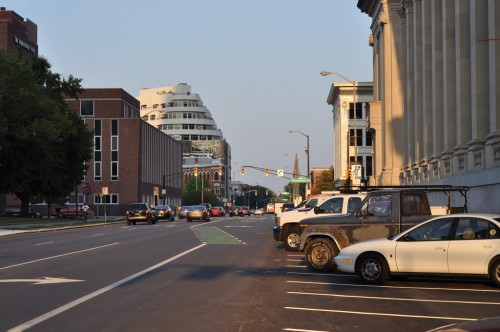
It should come as no surprise that my heart asks, why isn’t Indianapolis doing more of this? To be sure, we are making great strides here when it comes to cycling. I have been reporting the construction progress of the 62nd Street multi-use trail on Indy’s northside. The Cultural Trail is crawling forward to completion downtown. Next year, it is rumored, a bike share will open downtown along the Cultural Trail. Shelby Street is playing host to a new cycle track and this year, a 3rd jewel was added to our local crown of cycling races.
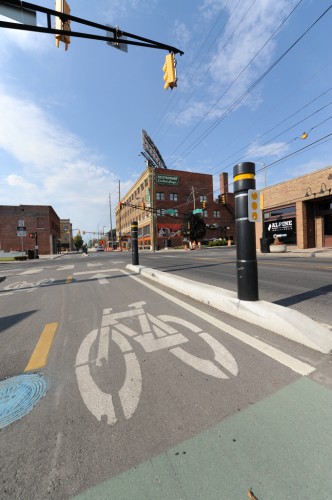
Yet, get out on a bike during rush hour and feel the wind at your back of a 40mph automobile speeding past, and you may think twice about braving the major through-fares that host what has become the standard Indianapolis bike lane. Pictured below, is an example of what you will find on a number of Indy’s bike routes; the single stripe right-next-to-traffic lane.
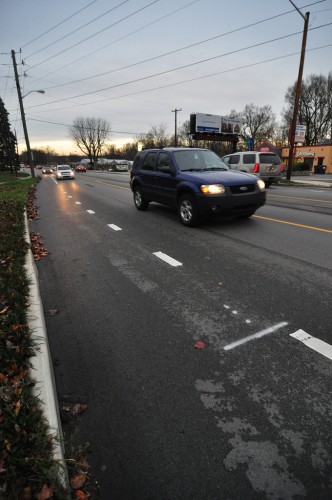
Cities across the nation are competing with each other in an increasingly high stakes game of bike infrastructure one-up-manship. Chicago is the latest player to the game with 33 miles of on street separated lane planned for this year. That is a TREMENDOUS achievement since this is a relatively new inroad for the city.
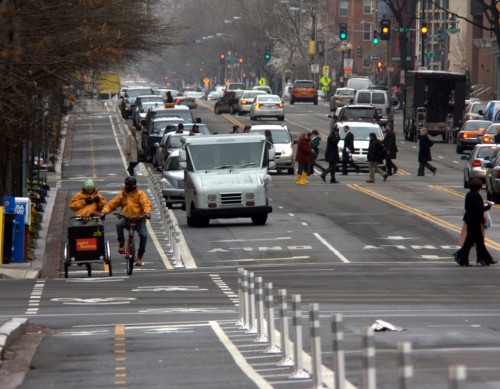
My question is this: If Chicago can do this so quickly, why can’t Indianapolis?
We are likely to see many more miles of the single stripe variant in the coming years. Those will go a long way towards alerting motorists that there are cyclists on the road, cell phones need to be put down, and respect needs to be given to all modes of transportation. However, if we want more cyclists on the road, and that answer should be yes for a multitude of reasons, my preference would be to see many more separate or double striped version such as those common to places like NYC and Portland.
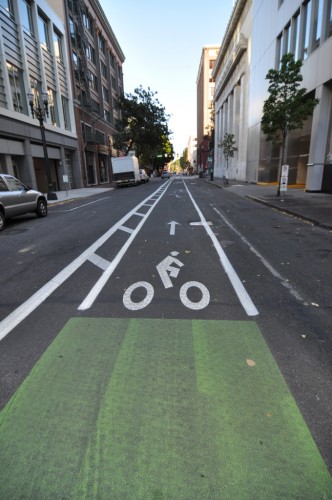
As always, the floor is now open for discussion.
I’ve always said that I’d rather have 10 miles of quality bicycling infrastructure (to loosely through together bike lanes, greenways, multi-use paths, etc… all in one term) than 50 miles of bicycling infrastructure that seems to vary in quality depending on a number of factors.
The question Indianapolis needs to ask is what is the goal of doing all this.
If the goal isn’t to attract more people to bike, but rather, to make the current bikers more visible, then we need to keep doing what we’re doing. We’re doing just that right now.
But if we’re trying to get more people to bike in more than recreational, even if it means only biking to work or to run errands once or twice a week, then I suspect we’re failing.
When I tell people that I bike from Pike Township to downtown and back to go to school or do some banking, they look at me as if I’m doing some sort of herculean effort (even though a lot of my typical route keeps me on a greenway most of the time, but I digress). And this is from people who are in way better shape than I am and could probably outride me given a bit of time to get used to cycling.
The reality is that there is a mental barrier from going from riding in your neighborhood or on the Monon to riding on the street. And that mental barrier doesn’t go away just because there is a bike lane there. Hell, I still have that barrier myself because even a somewhat experienced cyclist like myself won’t ride on Allisonville’s bike lane because I know people (like me!) drive like maniacs on Allisonville, even though it looks like a nice bike lane and fairly wide, street swept, etc…
That’s why I’ve always wished we could prioritize biking needs in this city. Some parts of the White River Greenway could really benefit from being re-paved due to tree routes encroaching under the trail. It doesn’t even need to be the entire trail, just specific parts of it. I’m sure the same can be said of other greenways, and hopefully the connectivity between the Cultural Trail and the Canal and other greenways will make downtown Indy more accessible to those living outside of the downtown area.
More segregated bike lanes. It doesn’t have to be a huge wall completely blocking you off from the site of traffic, since that’d make it hard to merge into traffic lanes if the lane ends. But do it similar to the Shelby Street lane, or the various spokes set up in the DC image.
And lets target streets for cyclists and encourage them to use specific roads, and then keep those roads in good condition. A bike tire can’t take the same type of wear and tear that a car tire can just shrug off. That’s part of why Illinois and Capital are still horrible rides for cyclists. It shoves all the cyclists into the bike lane, and then the bike lane has the worst conditions on the road.
As for a double striped bike lane, I’d like to see how it works before saying it rules or it sucks. I think most bike lanes need signage accompanying them. I know there’s been more than one instance where I’ve clearly been in a bike lane and a motorist would still get behind me, honking at me to speed up thinking it was a normal traffic lane even though he’s pretty much between two clearly separate lanes.
Sorry for the third comment in a row, but I really like how DC’s entire street is set up. And maybe it is because I just ddin’t notice it, but I don’t remember ever seeing something like that while I was there in 2006. Is this a recent development? Is that street picture from downtown or one of DC’s burbs?
I would like to see those 2″ tall round bumps (oversized Botts’ dots – http://en.wikipedia.org/wiki/Botts'_dots) placed along bike lanes. I think they would serve a similar role as the Solo cup lane markers. Having something there for the drivers to avoid is key.
I agree that these would be nice…however you need to take into consideration snow plows. All of the pictures in this wiki link are from places that don’t really have to deal with snow removal.
Doh! Apparently I’m an idiot. Good point.
Not an idiot at all. I had to be told the same thing a few years ago.
There are plow-tolerant, lower-profile lane reflectors, the ones INDOT sometimes uses on interstates and two-lane state highways.
Chris Barnett: I was hoping for some tactile feedback which those plow safe reflectors wouldn’t necessarily give. The large Botts’ dots would allow someone to hit something without damaging their car or destroying something like a bollard.
Rumble strip pavement might do the trick too.
Great comments from Matt Stone. I’ve still yet to see a bicyclist on Alisonville Road. Who, except the most hardcore street cyclist would ride next to 45MPH traffic. (The speed limit on Alisonville has always seemed too high to me, but I was really dumbfounded when the City didn’t lower it in conjunction with putting in the bike lane.)
I think separated lanes should be the norm and that we should prioritize creating a thorough network close to downtown before expending a lot of effort in the outlying areas, since the people most apt to cycle, and for whom cycling trips are most realistic, are likely to be in the denser areas of the inner-city. I’d love to see more separated lanes radiating outward from the Cultural Trail providing safer access for neighborhoods outside downtown and making connections with the existing greenways. How about separated lanes on Illinois and/or Capitol out to Fall Creek and eventually beyond to the Canal? How about separated lanes on New York out to the planned terminus of the Pogues Run Trail at Highland Park, and eventually beyond to Pleasant Run/Irvington/Pennsy? I’m sure there are more good routes that could be added, but those seemed to be the most obvious ones with access to the most potential riders nearby and the most connections to create a more thorough network on the north and east sides.
I bike most days along Allisonville Road (from about 56th to 82nd), and it’s actually quite pleasant. 🙂
The biking lanes are thick and usually padded and the traffic is always extremely respectful, especially at the intersections. They’ve done a good job along that stretch of road and while it could always be better, it’s good as it is. And, might I add, the up and down sections of the surprisingly hilly Allisonville road makes for a varied and challenging ride.
I think more/better bike lanes would be great, but you’re right…. there’s a mental block to get over, then a physical one. I don’t think more advanced biking lanes would do much to convert non-bikers to bikers. Regardless of the style of lane, getting into the lane is the hard part.
I agree that the more innovative bike lanes are quite nice and might get more cyclists out on the road who might not get on “standard” bike lanes. I would argue that Indianapolis is actually right up there with the rest of the cities out there. I have actually ridden on that DC cycletrack and saw that exact Portland lane last weekend (I actually thought it looked pretty sloppy). I also spent a week on my bicycle in Oregon the week leading up to this and I can tell you that 98% of the bike lanes I rode on and saw were “traditional” 5-6ft bike lanes without buffers. I can guarantee that there are buffered bike lanes and cycletracks that are coming here in Indy, but they are not necessarily applicable/feasible in all the situations that we have traditional bike lanes.
I would argue that the larger barrier to more people on the bike lanes is not necessarily the design….but our city’s density. People have made the decision to reside in neighborhoods that do not allow them to feasibly choose a bicycle as a means of transportation. So when you ask why Chicago can do it, but Indy can’t…I would say exactly that. Chicago has a mass of people that live in an urban area where the bicycle is a more convenient choice. I believe we are getting there with all the new residential/retail developments that are happening downtown and the re-flourishing of urban neighborhoods, but we are not there yet. This is not an excuse to not do it…but the demand is still rising and has not reached the tipping point where there is an overwhelming demand.
The last point is that the majority of the “traditional” bike lane projects in Indy are incorporated into resurfacing projects that are already scheduled for the roadways, so when a roadway is repaved the lanes can be reconfigured and/or a shoulder can be paved and striped to accommodate bikes and calm traffic….or it will be repaved the way it was before. Unfortunately, the funds that help add the bike lanes during resurfacing projects are not fungible and cannot be saved up for a “more innovative” project somewhere else in town.
It is because of the (lack of density) that I generally argue for completely separated multi-user paths.
.
On lightly-used streets, there is no real issue between cyclists and cars. The problem is the arterials, and that’s where long-distance trails like Fall Creek, Monon, Canal, and White River come into play. Those make Meridian Kessler and Butler Tarkington relatively “bike friendly” for commuting downtown without using Capitol/Illinois. Also Millersville/56th & Emerson and (someday) Lawrence.
I don’ t think that anyone (except vehicular cyclists) would argue with providing multi use trails when we can. However, when you live in an urban environment like Indianapolis, opposed to Carmel, space is limited. Not only that, but multi use paths are much more expensive. Once again, the majority of Indy’s on street bike lanes are incorporated into resurfacing jobs that are already happening so the cost is relatively minimal.
Also, on street bike lanes are able to provide much more direct routes between destinations for commuters. If you ride on bike lanes then there is a certain level of responsibility that must be assumed by the person on the bike as they are part of traffic.
Chicago moves at a different speed. Portland makes strides because of the population of younger generation. These cities are more likely to adopt the new trend or revised plan. I am proud of Indianapolis for remaining competitive. I appreciate those who will stand behind a decision for the betterment of the city. The focus is right on target for those who live downtown, and somewhat on target from those from the burbs.
Agree…separated bike lanes go a long way in making cyclists feel safer (and are indeed actually safer) than striped lanes directly adjacent to traffic flow. In my opinion, it would be an easy start to do these lanes on every one way street downtown. The streets have too many lanes, and we could start to claim some of these for bicycles. West Street, for example, could easily sustain a separated bike lane both north and south.
I saw another interesting bike lane in Minneapolis recently. It is on-street, but between the parked cars and the curb. If you enter 500 1st Ave North, Minneapolis into Googlemaps, you can view it in the aerial, but the Streetview pics are pre-bike lane redesign. It’s interesting to compare it with the Streetview which shows that the street was a one-way with three travel lanes and is now a two-way with one lane in each direction. Placing the bike lane between the curb and parked cars allows the flexibility of having an additional vehicle lane at rush hour. It looks like they also took care to prohibit parking about 50 feet prior to intersections to make sure the bicyclists are visible as they approach the intersection.
What do you all think of this design? Are there any streets in Indy that could easily be adapted to and benefit from this type of treatment?
Perhaps this link will get you there: http://goo.gl/maps/ZqW2S
West Seattle has the same type of lanes along Alki Beach on the Alki Trail. You can see it on Google Maps here: http://goo.gl/maps/qQSkK
.
The multiuse path is on the upper side of the parked cars while the driving lanes are below the parked cars. This trail is very heavily used.
Does Indy have a standard bike lane yet?
Indy uses the same national standard that Portland, Chicago and almost every other city does.
As a current resident (student) in Minneapolis, MN, I now see how convenient urban biking can be. I really believe having bike paths on a majority of the roads downtown is a must-have for any city trying to grow. I really think Indy has the potential to become as bike friendly as Minneapolis is.
I’d argue downtown is a friendly place to bike, bike lane or not. Most of the roads are wide with several lanes, and several are one way. Does anyone who bike regularly think Pennsylvania would be greatly improved by slapping a bike lane on it, or that you avoid Penn because it doesn’t have a bike lane?
The same can’t be said about many other roads outside of downtown. 56th street in Pike Township, which is one lane running each way with not much room to spare, has been greatly improved with a bike lane. I think it also benefitted by slightly widening the road (I believe some water sewer stuff was going on anyway) so not much traffic lane space was lost by adding the bike lane.
No, I don’t think there is much need for formal bike lanes downtown. Traffic is moving slowly (compared to surrounding roadways) and, as you say, the streets are wide. When I’m downtown, I tend to be crisscrossing the mile square anyhow, so it would be unlikely I’d utilize a bike lane consistently — unless every street had one!.
I just got back from Toronto and had my bike downtown. I did about 20-25 miles worth of biking on Friday. When comparing the type of bike infrastructure between Toronto and Indy, it is very similar. A fair amount of bike lanes, tons of sharrows, minimal separated bike tracks, and tons of streets with no bike markings at all.
.
The biggest difference is the number of bikers. In the morning and evening during rush hour, there would be groups of 10-20 bikers stopped at a light on the main cross-downtown thoroughfares. Drivers knew exactly what to do when they would approach a biker. This contrasted with Indy where drivers seem to be “WTF?” when they see a biker.
.
Hopefully with everything Indy is doing we will hit the critical mass in the near future.
As someone who commutes 10 to work every day from the south west side I have to say the bike lanes don’t exist in this area heading into down town. I guess we that live on the so w side are not in need of a bike lane.
Jim,
Not sure if you are new to Indy or what. The vast majority of people, including City Hall, don’t know or would like to forget the Southside even exists. I wouldn’t hold my breath waiting for anyone in the city to put any effort to the Southside.